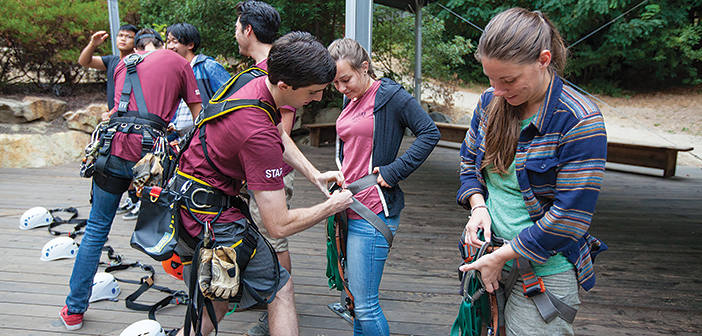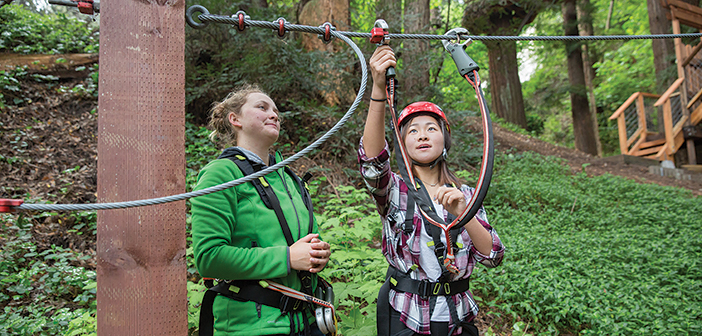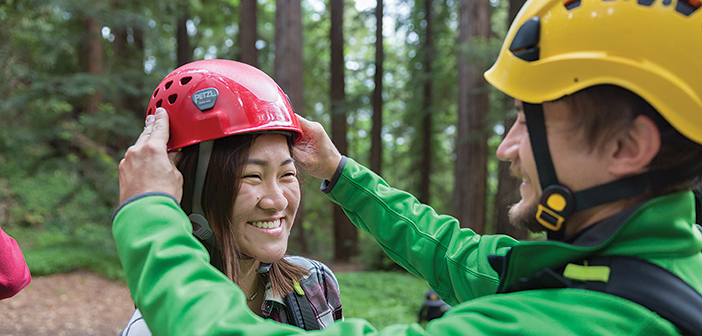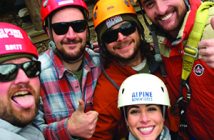We perform hundreds of activities on autopilot—making coffee, vacuuming the house, hitting “next episode” on Netflix—but guiding an aerial adventure shouldn’t be one of them. The temptation is high, though. As a zip line or challenge course facilitator, you spend your days leading groups through the exact same motions. But autopilot doesn’t make for a very memorable (or safe) guest experience. So, as a guide, how do you stick to your local operating procedure (LOP) and provide killer customer service?
It’s all about making great guest connections. In the participant lifecycle, there are four major opportunities for positive—or negative—guest interaction: orientation, gear-up, on the course, and wrapup. How you engage with your participants at each and every point during this lifecycle can make or break their day.
Here are some dos and don’ts to keep in mind.
Orientation
First impressions are important. As soon as participants arrive at your site, “people get out of their cars and are immediately judging the scene in front of them,” says Kevin Trump, training manager at Synergo, an ACCT accredited vendor that offers guide training and certification. The tone you set as you greet guests, collect paperwork, and deliver the participant briefing will have a lasting impact on the day.
Don’t forget guests are always watching and listening. Keep conversations with co-workers workplace appropriate. If I’m a guest, “I don’t need to hear how many beers you were drinking at your local establishment last night, because that is going to make me question whether you are ready to take care of me and my family today,” says Trump.
Do take the sunglasses off. “Participants want to know that there is a real person behind the sunglasses,” says Trump. Make eye contact throughout the orientation and gear-up.
Do “mind your pacing,” says Alex Moore, Synergo’s director of training. Guides know the briefing information inside out, but for most participants it will be their first time on the course. Slow down your delivery, and leave space for questions.
Don’t “fall into the habit of just listing information without checking for understanding,” says Trump. Ask your participants questions and get verbal affirmatives and negatives.
Do “read your audience,” says Bruce “Coach” Brown, director of training for Royal Gorge and Castle Rock Zip Line Tours. A riled-up bachelor party might need you to bring a calmer energy to the group. A group of two families who don’t know each other probably needs you to break the ice and stoke their enthusiasm.
Do play a name game. “If the group doesn’t learn each others’ names, that can be a real barrier to the experience,” says Moore.
Don’t harp on the scariest features when you describe the course, advises Brown: “A guide can make someone miserable for 11 lines by dwelling too much on one 1.5-second experience” at the end.
Do use “we” language if there will be other facilitators on the course. “It helps participants to feel that the whole team out on the course is there to help them,” says Moore.
Gear-Up
During the gear-up, you have an opportunity to talk one-on-one with guests as you help them into harnesses and helmets. If you take this opportunity to check in with participants, “gear time can be used as a really effective tool to mitigate emotional risk,” says MacKenzie Smith, Synergo’s programming manager.

Guides have an opportunity to connect with guests during gear-up and assess fears and risks.
Do “create an opportunity for the participants to let the guide know any pertinent information,” advises Trump. Confessing fears or pre-existing conditions in front of a group of 12 people can be intimidating for guests. Ask participants to share need-to-know info when they are one-on-one during the gear up.
Don’t inundate participants with information. “That can become overwhelming,” says Brown. Prioritize key information and consider other opportunities to share relevant but lower-priority info. “Most courses have a low and slow first few lines,” says Brown. “You can take those few lines to reinforce ideas or introduce new ones from ground school.”
Do “find out some information about people,” says Moore. “If you are in the zip line world and are stuck waiting on a platform, this moment in the gear up might give you something to connect with the guest on later down the line.”
Don’t use the gear up time to try out your new stand-up routine. “There are plenty of times to be funny and create rapport,” says Brown, “but ground school is also the guide’s final opportunity to decide if each participant can handle the course.”
Do have a verbal checklist, suggests Smith. Talking through your gear-up checklist out loud is a good way to make your guests feel more at ease and to ensure you
haven’t forgotten anything important.
On the Course
Guides wear many hats out on the course: safety facilitator, coach, hype-man, and photographer, among others. Catering to the different needs of a group of participants can be a real challenge. One guest might want to talk local flora and fauna, while another might be on the verge of vertigo-induced panic. “You need to have multiple approaches to guest interaction and delivery,” says Brown.
Do encourage participants, but don’t coerce them. “You want to act in a way that is going to empower people and make them feel good rather than make them feel forced,” Moore says.
Don’t be a “just one more step!” cheerleader. “If I am cheerleading you up there, we are going to ‘one more step’ someone into their panic zone,” says Trump. “The whole idea of the ‘one more step’ is kind of a lie to the participant anyway,” he adds.
Do “meet people where they are,” says Smith. Validate a participant’s experience by acknowledging when something is hard or scary instead of trying to push them past their fear.
Don’t goof around on the first lines. “You can always lighten up,” says Brown, “but it is very difficult to rein a group in.” Start with a more serious tone, “and then, as groups demonstrate they have the ability to handle the course, you can create opportunities to play around.”
Don’t “joke about or with people’s safety,” says Smith. “Like when someone steps off a platform and a guide jokingly calls out, ‘Oh I forgot to do—’. That’s 30 seconds where that person is sinking deep into their panic zone.”

Start with a serious tone and introduce playfulness once the group has shown they can handle the course.
But do have some “dad jokes” in your back pocket. “There are definitely jokes that will always make you crack up,” says Trump. Good jokes are the ones where everyone laughs with each other and not at one person.
Don’t ask questions if you aren’t interested in the answer. “I’ve seen guides ask the same questions of the same participant on a different platform,” says Moore, “which is really awkward because it shows that you weren’t listening the first time.”
Do know your course stats (longest line, top speed, etc.) and some facts about the area (the name of that mountain peak, the species of that tree, etc.). These can be easy and interesting conversation starters.
But don’t make stuff up. “Admit when you don’t know things,” says Brown. If you lie, “someone will Google it,” he warns, “and then they’ll wonder what else they can’t trust you about.”
Wrapup
Sometimes, the only time you have for your wrapup is the walk back up from the last line, so you have to make it count.
Do ask guests to share their takeaways from the day. “Sometimes we think of the commercial realm as just pay to play, but people can be changed from the experience,” says Moore.
One way to guide reflection: ask everyone to think of one word to describe their experience, then have them quickly rattle that word off in a one- word whip. “Maybe that then opens up an opportunity for organic conversation between participants,” says Trump.
Don’t talk tips—unless guests ask, says Brown. “If they ask about tips—‘can we tip you guys?’—you can say, ‘sure, thank you very much.’” Otherwise, says Brown, “don’t moan about it.”
Do thank your guests. “And that should be a sincere thing, not a lip-service thing,” says Brown. “Even if you felt like it was a rough tour group, you can’t know what the impact was on the guests.” Aim to shake everyone’s hand and look them all in the eye.
“Once you’re done, everyone, no matter how much fun they’ve had, is excited to get out of their gear,” Brown acknowledges. So, the wrapup often gets overlooked. But skipping or rushing this last opportunity to connect with participants is a mistake as far as creating a positive guest experience goes.
From start to finish, a guide plays the biggest role in the experience, says Smith. “Remember, when you are in that position as a guide or facilitator, everything you say and do can change the experience of the participants.”





